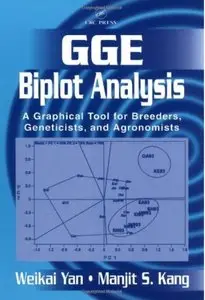Weikai Yan, Manjit S. Kang - GGE Biplot Analysis: A Graphical Tool for Breeders, Geneticists, and Agronomists
Published: 2002-08-28 | ISBN: 0849313384 | PDF | 288 pages | 5 MB
Research data is expensive and precious, yet it is seldom fully utilized due to our ability of comprehension. Graphical display is desirable, if not absolutely necessary, for fully understanding large data sets with complex interconnectedness and interactions. The newly developed GGE biplot methodology is a superior approach to the graphical analysis of research data and may revolutionize the way researchers analyze data. GGE Biplot Analysis: A Graphical Tool for Breeders, Geneticists, and Agronomists introduces the theory of the GGE biplot methodology and describes its applications in visual analysis of multi-environment trial (MET) data and other types of research data.
The text includes three parts: I) Genotype by environment interaction and stability analysis, II) GGE biplot and multi-environment trial (MET) data analysis, and III) GGE biplot software and applications in analyzing other types of two-way data. Part I presents a comprehensive but succinct treatment of genotype-by-environment (G x E) interaction in order to provide an overall picture of the entire G x E issue and to show how GGE biplot methodology fits in. Part II describes and demonstrates the numerous utilities of a GGE biplot in visualizing MET data. Part III describes the "GGE biplot" software and extends its application to the analysis of genotype by trait data, QTL mapping data, diallel cross data, and host by pathogen data. Altogether, this book demonstrates that the GGE biplot methodology is a superior data-visualization tool and allows the researcher to graphically extract and utilize the information from MET data and other types of two-way data to the fullest extent.
GGE Biplot Analysis makes this useful technology accessible on a wider scale to plant and animal breeders, geneticists, agronomists, ecologists, and students in these and other related research areas. The information presented here will greatly enhance researchers' ability to understand their data and will make a significant contribution toward helping to meet the challenges of food production and food security that currently face the world. Readers will be amazed to see how much more they can extract from their data by implementing the new and easily understood GGE biplot methods presented here and will soon agree that any delay in using this technique is a loss to their research achievement.



